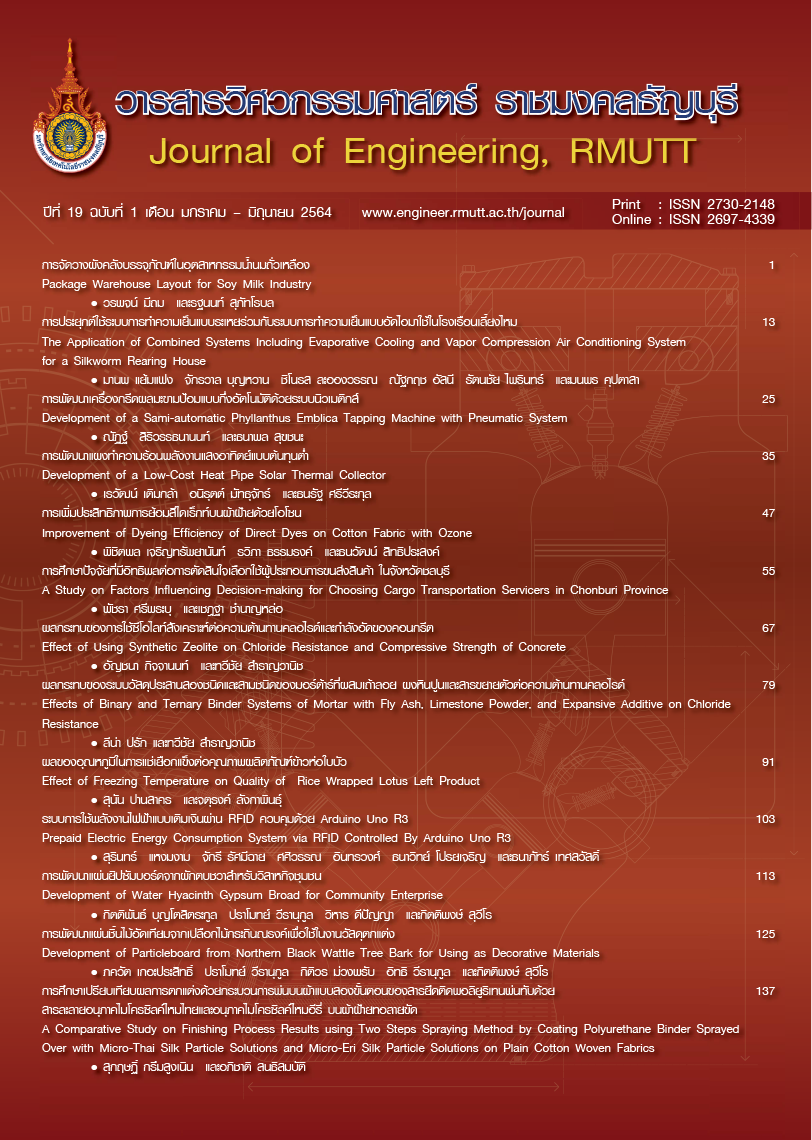การประยุกต์ใช้ระบบการทำความเย็นแบบระเหยร่วมกับระบบการทำความเย็นแบบอัดไอมาใช้ ในโรงเรือนเลี้ยงไหม
##plugins.themes.bootstrap3.article.main##
摘要
งานวิจัยนี้เป็นการศึกษาการเปลี่ยนแปลงของอุณหภูมิและความชื้นในโรงเรือนเลี้ยงไหม โดยการใช้ระบบการทำความเย็นแบบระเหยร่วมกับระบบการทำความเย็นแบบอัดไอ โดยทำการทดลองในโรงเรือนที่มีขนาดกว้าง 10 เมตร ยาว 21 เมตร สูง 3 เมตร สำหรับระบบการทำความเย็นแบบระเหยจะทำการติดตั้งแผ่นระเหยน้ำขนาดกว้าง 1.5 เมตร สูง 1.8 เมตร หนา 0.15 เมตร จำนวน 6 ชุด บนผนังด้านทิศใต้ของโรงเรือน และมีพัดลมดูดอากาศขนาด 30 นิ้ว จำนวน 6 ตัว ติดตั้งที่ผนังด้านทิศเหนือของโรงเรือน ส่วนระบบการทำความเย็นแบบอัดไอนั้นจะใช้เครื่องปรับอากาศขนาด 30,000 Btu/hr จำนวน 4 เครื่อง ผลการทดลองจากโรงเรือนที่ใช้ระบบการทำความเย็นแบบระเหยสำหรับเลี้ยงไหมวัย 1 วัย 2 และวัย 3 พบว่ามีค่าความแตกต่างเฉลี่ยจากอุณหภูมิเหมาะสมสำหรับเลี้ยงไหมวัยดังกล่าวคือ 0.4oC 1.0oC และ1.9oC ตามลำดับ สำหรับความชื้นสัมพัทธ์ของอากาศในโรงเรือน มีค่าความแตกต่างเฉลี่ย 6.09% 0.61% และ 3.29% ตามลำดับ ส่วนระบบการทำความเย็นแบบอัดไอที่ใช้เลี้ยงไหมวัย 4 และวัย 5 นั้นพบว่าค่าความแตกต่างเฉลี่ยของอุณหภูมิและความชื้นสัมพัทธ์ของอากาศเหมาะสม สำหรับการเลี้ยงไหมวัย 4 คือ 2.2oC 0.33% และ 3.1oC 4.86% สำหรับไหมวัย 5
##plugins.themes.bootstrap3.article.details##
The manuscript, information, content, picture and so forth which were published on Frontiers in engineering innovation research has been a copyright of this journal only. There is not allow anyone or any organize to duplicate all content or some document for unethical publication.
参考
Chuprayoon S. Silk production techniques. Department of Agricultural Extension. 80 p.
John A, Zahra Giabaklou. A passive evaporative cooling system by natural ventilation. Building and Environment. 1996;31(6):503-7.
Dai Y.J, Sumathy K. Theoretical study on a cross–flow direct evaporative cooler using honeycomb paper as packing material. Applied Thermal Engineering. 2002;(22): 1417-30.
Maheshwari G.P, Al-Ragom F, Suri R.K. Energy-saving potential of an indirect evaporative cooler. Applied Energy. 2001;(69):69-76.
Faleh Al-Sulaiman. Evaluation of the performance of local fibers in evaporative cooling. Energy Conversion and Management. 2002;(43):2267-73.
Hisham T.A, El-Dessouky, Amir A.Al-Haddad, Faisal Al-Juwayhel. Thermal and hydraulic performance of a modifide two-stage evaporative cooler. Renewable Energy. 1996;7(2):165-76.
Jain J.K, Hindoliya D.A. Experimental performance of new evaporative cooling pad materials. Sustainable Cities and Society. 2011;(1): 252-6.
Pervin A.D, Saffa R, Guohui G, Devrim A. Experimental study of the potential of eucalyptus fibres for evaporative cooling. Renewable Energy. 2019;(131):250-60.
Xu J, Li Y, Wang R.Z, Liu W, Zhou P. Experimental performance of evaporative cooling pad systems in greenhouses in humid subtropical climates. Applied Energy. 2015; (138):291-301.
Singh A, Kumar S, Dev R. Studies on cocopeat, sawdust and dried cow dung as desiccant for evaporative cooling system. Renewable Energy. 2019;(142):295-303.

